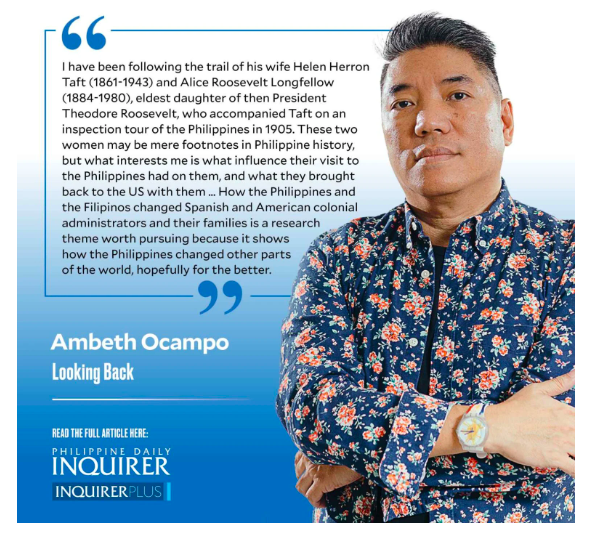Women in Philippine history
When my social media channels got flooded with posts on International Women’s Day, I wondered, what about International Men’s Day? As I looked around for a suitable topic on women in Philippine history, I realized I had already written on Andres Bonifacio’s widow, Gregoria de Jesus, before. I already published a compilation of essays, “Queridas de Rizal,” on the national hero’s romantic entanglements. I’ve written on the mythical Princess Urduja, an Amazon from the Land of Tawalisi, who spoke Turkish and could beat any man in hand-to-hand combat. Based on Rizal’s calculations, Urduja’s realm, as described by the 14th-century explorer Ibn Battuta, lies in Northern Luzon, somewhere around Pangasinan!
“Women carry half the sky,” said Mao Zedong, so what would our male heroes be without women? Wasn’t Rizal formed by a household with a strong-willed mother and nine sisters? Laureana Novicio was once hailed as the greatest mother in Philippine history for producing the overachieving Luna brothers: Manuel (violinist), Juan (painter), Jose (physician), Antonio (chemist and tragic general of the Philippine-American War) and Joaquin (politician). Wasn’t Laureana’s birthplace, Namacpacan, renamed Luna, La Union in 1906 in her honor by her son Joaquin? Where would Felix Resurreccion Hidalgo’s art be without the financial support from Maria Barbara Padilla, aka “Doña Baritay,” a successful 19th-century businesswoman?
What would Emilio Aguinaldo be without his mother Trinidad Famy who supported him on the road from Cavite Viejo (now Kawit) mayor to the presidency of the Malolos Republic? Didn’t she watch from a window as Gen. Antonio Luna, her son’s rival, was assassinated in Cabanatuan in 1899? After the deed, she is said to have shouted at the assassins circling the corpse, “nagalaw pa ba iyan? (Is it still moving?)” What influence did mothers have on our presidents? Josefa Edralin on Ferdinand E. Marcos Sr.; Imelda Marcos on Ferdinand R. Marcos Jr.; Corazon Aquino on Benigno S. Aquino III; Maria “Doña Mary” Marcelo on Joseph Estrada; even Eva Macapagal on Gloria Macapagal Arroyo. Sigmund Freud would have a lot to say on the oedipal in Philippine history.
My current reading has shifted from the Spanish to the early American period due to the primary sources I have been dipping into at the University of Michigan. My stay of four months in Ann Arbor isn’t enough to even get a sense of what is available. While I have been going through a lot of papers relating to William Howard Taft, who served as civil governor of the Philippines before rising to become 27th president of the United States and later 10th chief justice of the US Supreme Court, I have been following the trail of his wife Helen Herron Taft (1861-1943) and Alice Roosevelt Longfellow (1884-1980), eldest daughter of then President Theodore Roosevelt, who accompanied Taft on an inspection tour of the Philippines in 1905. These two women may be mere footnotes in Philippine history, but what interests me is what influence their visit to the Philippines had on them, and what they brought back to the US with them.
As first lady, Mrs. Taft introduced many innovations into the social life of Washington that she learned in Manila. For example, parties used to be stuffy indoor affairs, until Mrs. Taft popularized informal garden parties, something she brought back from Manila, like her husband’s unnamed Filipino valet. In her 1914 memoir, “Recollections of Full Years,” (the first by a US first lady), she wrote:
“That Manila could lend anything to Washington may be an idea that would surprise some persons, but the Luneta is an institution whose usefulness to society in the Philippine capital is not to be overestimated. At least it was so in my day; and for a long time before Mr. Taft became President I had looked with ambitious designs upon the similar possibilities presented in the drives, the river-cooled air and the green swards of Potomac Park. I determined, if possible, to convert Potomac Park into a glorified Luneta where all Washington could meet, either on foot or in vehicles, at five o’clock on certain evenings, listen to band concerts and enjoy such recreation as no other spot in Washington could possibly afford.”
How the Philippines and the Filipinos changed Spanish and American colonial administrators and their families is a research theme worth pursuing because it shows how the Philippines changed other parts of the world, hopefully for the better.
——————
Comments are welcome at [email protected]
Disclaimer: The comments uploaded on this site do not necessarily represent or reflect the views of management and owner of Cebudailynews. We reserve the right to exclude comments that we deem to be inconsistent with our editorial standards.

